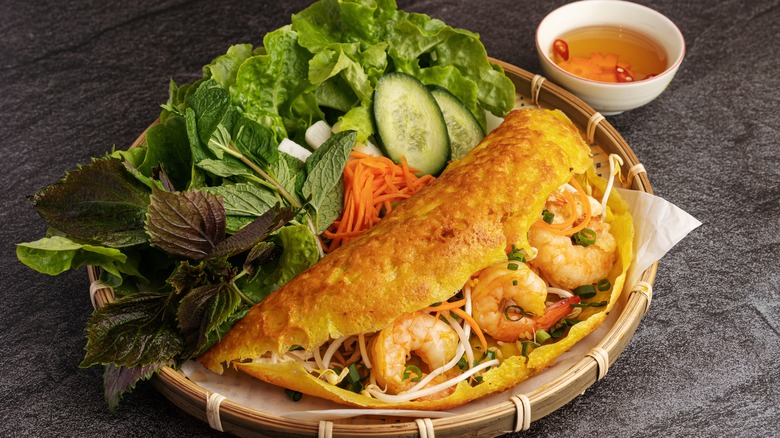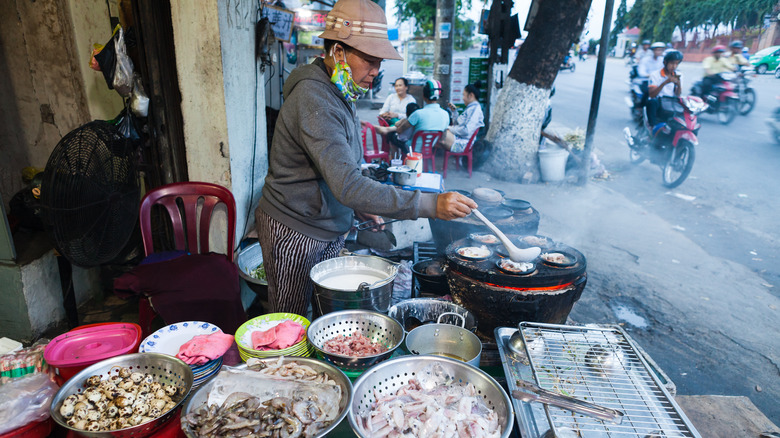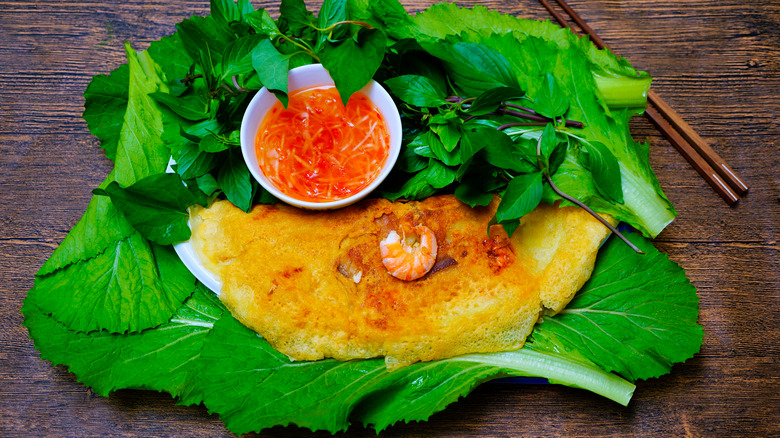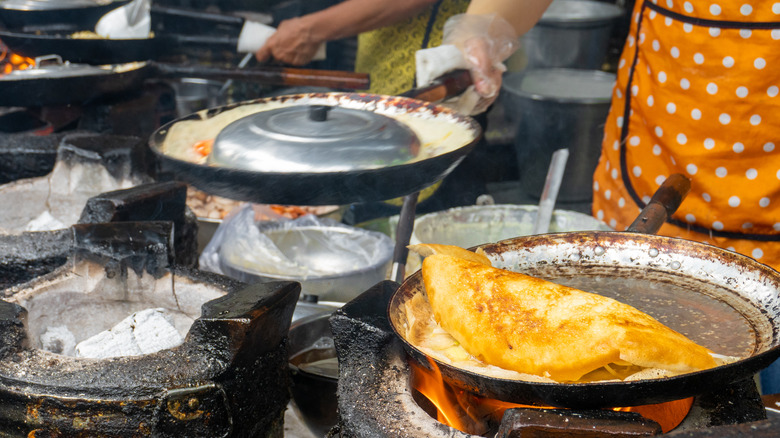Bánh Xèo: The Delectable Vietnamese Crepes You Should Know
You may know phở or bánh mì, but do you know the other diverse and delicious dishes that make up the Vietnamese street food scene? Vietnamese food is known for its simple, yet fresh, delectable ingredients. As CNN put it, "It's precisely this simplicity, the subtle variations by region and the fresh ingredients, that keep us pulling up a plastic stool for more."
For example, Bún bò Huế, or beef noodles, are known for their rich broth and tender meat. The thicker-than-normal noodles are also a coveted addition. Another favorite is Bánh khọt, small crispy pancakes. They are shaped like tiny bowls and filled with shrimp, green onion, and mung beans, according to Nomad Paradise.
Similar to this is bánh xèo. A thin, crispy crêpe filled with juicy meat and crunchy veggies. This nationwide favorite is a street-food staple but looks different based on where you're visiting in Vietnam.
History of bánh xèo
According to Saigoneer, the exact origins of the dish are unclear. While it is unknown who invented the pancake or what dish inspired it, it is widely agreed that it was invented in Central Vietnam during the Tay Son era. The Tay Son movement occurred between 1771 and 1802, and was "a cataclysmic event that greatly altered the 18th century Vietnamese political and social landscape," writes the International Institute for Asian Studies.
Historically, bánh xèo was made as a convenient meal for farmers. It then became popular with food carts, but it was still primarily a dish for the working class. However, according to the Saigoneer, the bánh xèo eventually worked its way into restaurants. The site writes, "Today, famous chains like Banh Xeo Muoi Xiem and An La Ghien are known nationwide though, if you ask us, the street-side variety is still the best." This dish can now be found on roadsides in modest-looking stands or upscale establishments. The Saigoneer also notes that many different regional styles have also grown in popularity across Vietnam, "and showcase a range of local ingredients depending upon the region it's served."
The name also simply comes from the sound the crêpe makes while cooking. Allrecipes writes, "the name means 'sizzling pancakes or crêpes' and refers to the sound the batter makes when it hits the hot skillet.
Ingredients in bánh xèo
While the dish looks deceivingly simple, it is actually relatively complex to balance the great texture, flavors, and temperature, according to Cook's Illustrated. The version in Ho Chi Minh City consists of a turmeric-seasoned crêpe stuffed with tiny shrimp, fluffy rice, and rich pork belly. It is also commonly wrapped with large lettuce and herbs for added texture and flavor. A mixture of fish sauce, lime juice, sugar, and chiles is also a common dipping sauce (via Cooks Illustrated).
However, many regions dress it up differently. According to Saigoneer, many central provinces, like Quang Ngai or Quang Nam, often wrap the dish in rice paper rather than a lettuce leaf. The site also notes that southern provinces, like Can Tho and Saigon, are very similar to the Ho Chi Minh City version where "giant crêpes packed with mung bean and pork, shrimp, bean sprouts and come with an accompanying plate of herbs and fresh greens."
At fancier establishments, "Chefs in central Vietnam include star fruit and banana among their accompaniments, while southern chefs might toss mushrooms, coconut or even lotus into their pancakes," writes the Saigoneer. The size also changes, and often the dish is larger in the South and smaller in the North.
How bánh xèo is made
Cook's Illustrated notes that this dish is a bit of a process to perfect. To start, if attempting a southern rendition, the pork and shrimp must first be stir-fried with thinly sliced onions. Once cooked, the mixture is pushed to one side of the pan, and the crêpe batter is added to fill the empty area.
It is important to remember the "xèo" part of the dish's name when preparing it. Xèo means "sizzling" and is an "onomatopoeic" name. The batter should hit the hot skillet, and sizzle audibly. The crepe is then cooked until the bottom is quite crispy, but the top should still be tender and custardy. At this point, a handful of bean sprouts can be added to the filling. The filling is then encased by folding the dish in half. It is then ready to eat with the garnishes and dipping sauce of choice, as Cook's Illustrated writes.
Allrecipes, alternatively, bake the batter, rather than pouring it onto a hot skillet. While not as traditional, they stir fry the filling, then pour the batter onto the skillet, coating the bottom. They then place the filling on top and bake until the batter is set and the edges are brown.



